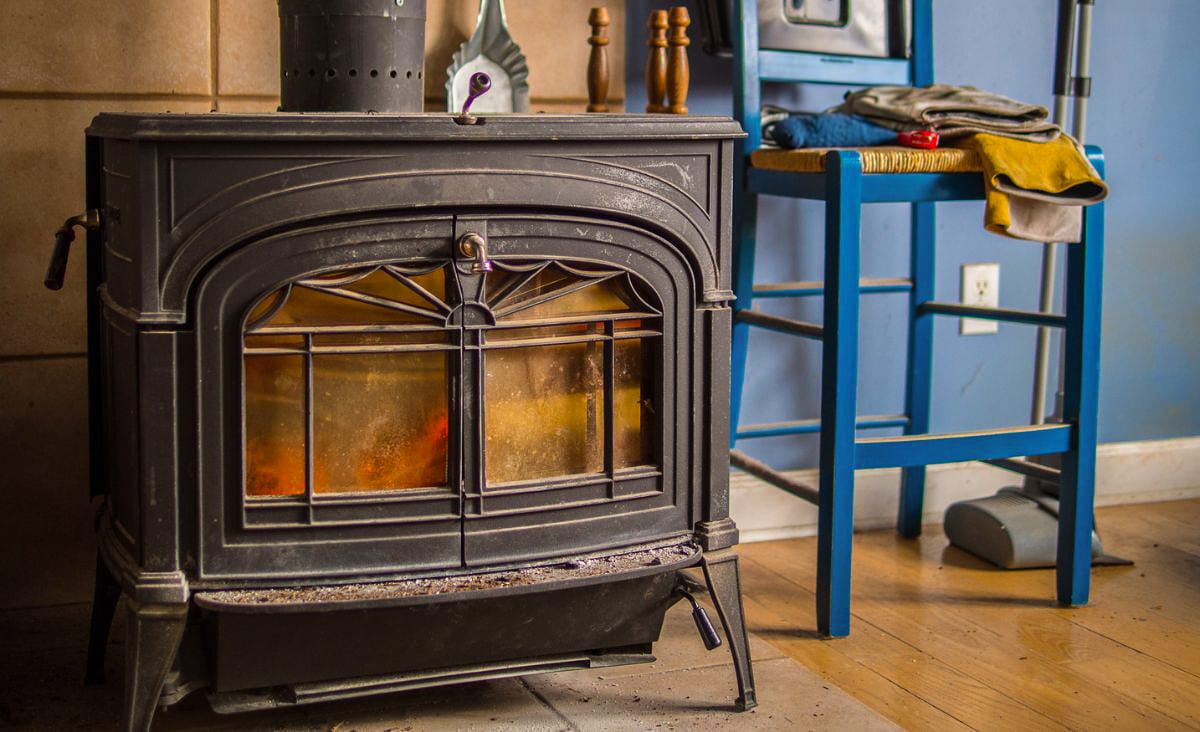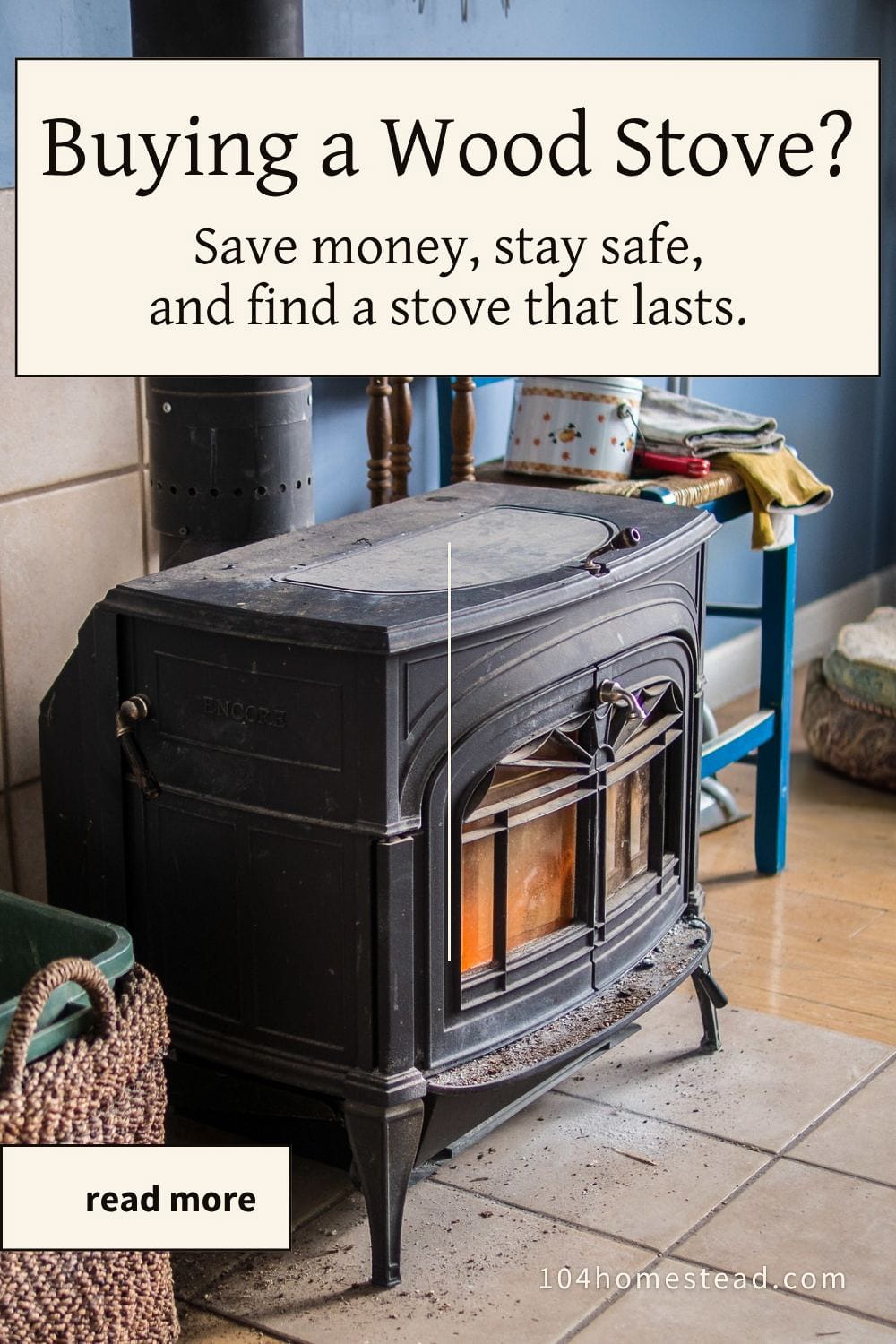How to Choose a Wood Stove (with a Free Used Stove Inspection Checklist)
Learn how to choose a wood stove that fits your home and budget. Get a free printable checklist to inspect used stoves safely before you buy.

Nothing beats the crackle of a wood stove on a cold night, especially when you know you’re not relying on oil or the grid. But finding the right stove isn’t as simple as picking the prettiest one at the hardware store. There’s a lot to think about… size, efficiency, safety, and whether it really fits your life.
After years of heating exclusively with wood here in Maine, I’ve learned that a little planning makes all the difference. Here’s what I’ve learned (sometimes the hard way) about choosing a stove that fits your space and keeps you toasty through winter.
How to Pick the Right Size Wood Stove
Sizing a stove doesn’t need to be complicated. Stoves are measured in BTUs, which is just a fancy way of saying how much heat they put out. More BTUs = more heat, but too much and you’ll roast yourself out of the room. Too few, and you’ll be up all night feeding it and wondering why you’re still cold.
| Home Size (sq ft) | Poor Insulation | Average Insulation | Excellent Insulation |
|---|---|---|---|
| 500–800 sq ft | 20,000–30,000 BTU | 12,000–24,000 BTU | 10,000–20,000 BTU |
| 800–1,200 sq ft | 30,000–45,000 BTU | 20,000–35,000 BTU | 16,000–30,000 BTU |
| 1,200–2,000 sq ft | 45,000–70,000 BTU | 30,000–50,000 BTU | 24,000–40,000 BTU |
| 2,000+ sq ft | 70,000+ BTU | 50,000–70,000 BTU | 40,000–55,000 BTU |
Open layouts heat easier. Older, chopped-up homes usually need a doorway fan (or five) to move the warm air around.
If you’re heating your entire home, lean toward a slightly higher BTU model. For backup or weekend use, something smaller and more efficient is easier to manage.
Catalytic vs. Non-Catalytic vs. Hybrid Stoves
One of the first things you’ll run into when stove shopping is the ‘catalytic vs. non-catalytic’ debate. Each type burns a little differently. Some need more babysitting, some are low-maintenance workhorses. Here’s the quick rundown of what that really means.
| Feature | Catalytic Stove | Non-Catalytic Stove | Hybrid Stove |
|---|---|---|---|
| How It Works | Uses a catalytic combustor to re-burn smoke and gases | Uses airflow and baffles to burn smoke without a catalyst | Combines both technologies |
| Efficiency | Highest (up to 90%) | Moderate (60–75%) | High (often 80–85%) |
| Burn Time | Long and steady (great for overnight) | Shorter, requires more frequent loading | Long, even burns with less babysitting |
| Maintenance | Needs periodic catalyst replacement | Minimal maintenance | Moderate, clean both systems |
| Ease of Use | Takes a little more finesse | Simplest to use | Pretty simple |
| Best For | Primary heat source, 24/7 burning | Occasional or weekend heating | Full-time use with less fuss |
Heating full-time through winter? Go catalytic or hybrid. Just want weekend fires? A non-cat will be just fine.
EPA Certification, Efficiency & Local Codes
Today’s stoves are miles better than the old smoky ones, but still check the details, especially if you’re buying used. Look for:
- An EPA label (cleaner burn, better efficiency).
- A UL or ULC safety listing for electrical and structural standards.
- Whatever your local code office requires for permits and inspections. Most towns want you to do this before install.
That little EPA tag doesn’t look like much, but it saves wood, money, and time on chimney cleanings.
Installation & Cost Breakdown
The stove is the fun part. The chimney, pad, and permits are where the costs creep up.
| Expense | Typical Cost Range | Ways to Save |
|---|---|---|
| Stove | $1,500–$4,000 | Check local classifieds for a solid used stove. |
| Chimney or venting system | $800–$2,000 | |
| Hearth pad & floor protection | $200–$800 | Shop in spring or summer. Prices are better. |
| Professional installation | $1,000–$3,000 | If you’re swapping out an old stove, it can be a manageable DIY job (with a little help from YouTube). |
| Permits & inspections | $100–$300 | |
| Accessories (fans, thermometers, etc.) | $50–$200 |
Heating with wood gets a lot cheaper when you can source it for free. Here’s how I find free firewood locally.
Placement, Clearance & Heat Distribution
Stove placement isn’t just about looks. It affects heat flow, safety, and efficiency. I’ve seen so many people tuck their stove in a corner of their living room and wonder why their kitchen still feels like the Arctic. Keep in mind:
- Central placement heats most evenly.
- Follow your model’s clearances (18–36″ from walls is common).
- Use a hearth pad with the proper R-value.
- Add doorway or ceiling fans to circulate air between rooms.
- A heat-powered stove fan helps push warm air without using electricity.
If your home’s more closed off, these small tweaks can make a big difference in how evenly it heats.
Materials, Style & Aesthetic
Sure, it’s there to heat your house, but it’s also going to sit front and center for years. Might as well pick one you actually like looking at. Here’s how the main materials compare:
| Material | Heats Up | Holds Heat | Best For |
|---|---|---|---|
| Steel | Fast | Cools quickly | Quick bursts of heat, modern look |
| Cast Iron | Moderate | Long-lasting warmth | Rustic homes, classic look |
| Soapstone | Slow | Exceptional retention | Steady, all-day heat and traditional charm |
I once sold a cracked soapstone stove for pennies, thinking it was junk. Turns out it just needed new stone. My buyer was grabbing scraps from a countertop place. Still kicking myself for that one.
Matte black hides soot. Enamel looks great but shows dust faster.
Buying a Used Wood Stove
A used stove can be a steal, but only if it’s safe and up to code. Check for the EPA label, look inside for cracks or warped metal, and make sure the door seals snug. A loose door is a red flag and may not be an easy (or possible) fix.
I made a printable Used Wood Stove Inspection Checklist you can take along when you’re stove shopping secondhand.
Maintenance Basics
Keeping your stove in shape means it’ll last longer and run safer. Here are some seasonal tasks:
- Get your chimney swept once a year, or more if you’re running it day and night from November through March like I do.
- Inspect door gaskets and firebricks before each season.
- Empty the ash pan often, but leave a thin layer behind. It helps insulate new fires. Not sure what to do with all that ash? Use it in the garden.
- Check your smoke and CO detectors monthly.
If you want to take it a step further, here’s how I store firewood so it stays dry and ready to burn.
Still Have Wood Stove Questions?
Choosing a wood stove can bring up a lot of what-ifs. Let’s cover a few of the common ones so you can head into stove shopping with fewer question marks.
Getting a wood stove soon? Keep this guide handy by pinning it now.

Buying a wood stove isn’t cheap, but the right one pays you back every winter, especially if you lose power a lot. Take your time choosing the right size, learn a bit about stove types, and make sure your setup’s safe. Once it’s burning, you’ll understand why so many of us can’t imagine winter without it.
If you’re stove shopping soon, grab the Used Wood Stove Inspection Checklist and save yourself some headaches later.
